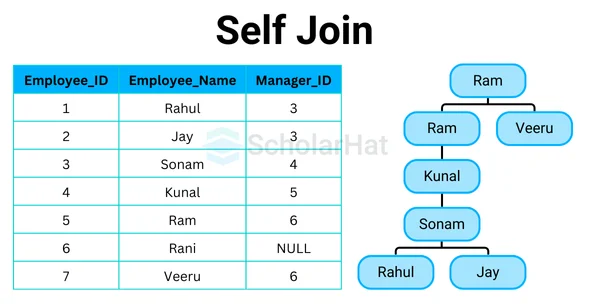13
DecSelf Join in SQL: A Step-by-Step Guide
SELF JOIN in SQL
SELF JOIN in SQL is an approach to merge a table with itself. Comparing rows inside the same table or arranging the data in the table so that it makes sense might be helpful. By combining a table with itself and utilizing distinct aliases to distinguish between numerous instances, you may get relevant data in SQL with a SELF JOIN.
In this SQL Server Tutorial, you will understand the SELF JOIN in SQL, including when should you use SELF JOINs in SQL, Syntax for the SELF JOIN in SQL, SELF JOIN example, advantages of SELF JOIN in SQL, common use cases for SELF JOIN in SQL, and many more. SQL Server skills can boost your earning potential by 22% in the next 3 years. Enroll in our Free SQL Server Course with Certificate today!
What is SELF JOIN in SQL?
SELF JOIN in SQLis simply a regular type of JOIN in SQL where a table is joined with itself. The same table is referenced twice in the query with different aliases, which allows for comparing rows within that table or organizing hierarchical data. SELF JOIN in SQL can be beneficial when you want to relate rows in a single table, such as finding relationships between employees and their managers or identifying parent-child structures.

When should you use a SELF JOIN in SQL?
There are some important situations where you should use SELF JOIN in SQL where:
- You need to compare rows in a table.
- You have hierarchical data in a single table, such as an employee reporting structure.
- There is a parent-child relationship within the same dataset.
Read More - SQL Interview Questions And Answers For Freshers
How does SELF JOIN work in SQL?
In a SELF JOIN in SQL, a table is treated as if it were two separate tables. You use aliases to refer to these two different instances of the same table, then perform the join based on the relationship between columns.
Syntax for a SELF JOIN in SQL
SELECT a.column1, b.column2
FROM table_name a
JOIN table_name b
ON a.common_column = b.common_column; Here, a and b are aliases for the same table, and the join condition is defined in the ON clause.
Example Scenario
Consider having an Employee table with data on workers and their supervisors. Every staff member possesses a Manager_ID, which links to their manager's Employee_ID.
Here is the structure of the Employee table:
| Employee_ID | Employee_Name | Manager_ID |
| 1 | Ankit | NULL |
| 2 | Rakesh | 1 |
| 3 | Shalini | 1 |
| 4 | Manish | 2 |
| 5 | Priya | 2 |
Example
To find out the name of each employee along with their manager’s name, we can use a Self JOIN:
SELECT e1.Employee_Name AS Employee, e2.Employee_Name AS Manager
FROM Employee e1
LEFT JOIN Employee e2
ON e1.Manager_ID = e2.Employee_ID; Explanation:
- We use e1 and e2as aliases for the same Employee table.
- The join condition e1.Manager_ID = e2.Employee_ID ensures that the employee’s Manager_ID matches the Employee_ID of their manager.
- The LEFT JOIN is used to ensure that employees without a manager (like Ankit, who is at the top of the hierarchy) still appear in the result.
Result:
| Employee | Manager |
| Ankit | NULL |
| Rakesh | Ankit |
| Shalini | Ankit |
| Manish | Rakesh |
| Priya | Rakesh |
Self Join with ORDER BY Clause
The ORDER BY clause in a SELF JOIN in SQL sorts the result based on one or more columns from either of the joined instances of the same table. It helps arrange the result set in ascending or descending order.
Syntax of Self Join with ORDER BY Clause
SELECT a.column1, b.column2
FROM table_name a
JOIN table_name b
ON a.common_column = b.common_column
ORDER BY a.column1 ASC, b.column2 DESC; Example
Consider the Employee table and sort the results according to the manager's name in descending order and the employee's name in ascending order.
SELECT e1.Employee_Name AS Employee, e2.Employee_Name AS Manager
FROM Employee e1
LEFT JOIN Employee e2
ON e1.Manager_ID = e2.Employee_ID
ORDER BY e1.Employee_Name ASC, e2.Employee_Name DESC; Result
| Employee | Manager |
| Ankit | NULL |
| Manish | Rakesh |
| Priya | Rakesh |
| Rakesh | Ankit |
| Shalini | Ankit |
Some Other Examples of SELF JOIN in SQL
1. Compare Columns In The Same Table
Suppose we have a table Employees with employee details like EmployeeID, Name, and ManagerID, and we want to compare an employee with their manager to get both of their names.
| EmployeeID | Name | ManagerID |
|---|---|---|
| 1 | Ankit | NULL |
| 2 | Ravi | 1 |
| 3 | Sneha | 1 |
| 4 | Priya | 2 |
Query:
SELECT e1.Name AS Employee, e2.Name AS Manager
FROM Employees e1
JOIN Employees e2 ON e1.ManagerID = e2.EmployeeID;
2. Identify Duplicate Rows
Assume we have a table Students where we suspect some rows may be duplicated based on names.
| StudentID | Name | Class |
|---|---|---|
| 1 | Amit | 5 |
| 2 | Sumit | 5 |
| 3 | Amit | 5 |
Query:
SELECT s1.StudentID, s1.Name, s1.Class
FROM Students s1
JOIN Students s2 ON s1.Name = s2.Name AND s1.Class = s2.Class
WHERE s1.StudentID > s2.StudentID;
3. Hierarchical Data
Let's say we have a Departments table where each department has a parent department, and we want to display both the department and its parent.
| DeptID | DeptName | ParentDeptID |
|---|---|---|
| 1 | Corporate | NULL |
| 2 | HR | 1 |
| 3 | IT | 1 |
| 4 | Recruitment | 2 |
Query
SELECT d1.DeptName AS Department, d2.DeptName AS ParentDepartment
FROM Departments d1
LEFT JOIN Departments d2 ON d1.ParentDeptID = d2.DeptID;
4. Comparing Historical Snapshot Data
Suppose we have a Sales table containing monthly sales data for different products, and we want to compare the sales for a product across two different months.
| ProductID | Month | Sales |
|---|---|---|
| 1 | Jan | 100 |
| 1 | Feb | 150 |
| 2 | Jan | 200 |
| 2 | Feb | 220 |
Query:
SELECT s1.ProductID, s1.Month AS Month1, s1.Sales AS Sales1,
s2.Month AS Month2, s2.Sales AS Sales2
FROM Sales s1
JOIN Sales s2 ON s1.ProductID = s2.ProductID
WHERE s1.Month = 'Jan' AND s2.Month = 'Feb';
Advantages of SELF JOIN in SQL
- Hierarchical Data Handling: SELF JOINs are particularly useful in dealing with hierarchical or recursive data, like organizational charts where employees report to managers.
- Flexible Queries: You can compare different rows within the same table, enabling complex queries without needing multiple tables.
- Simpler Database Structure: Instead of creating multiple tables for hierarchical or related data, you can use a SELF JOIN in SQL to manage everything within one table.
Common Use Cases for SELF JOIN in SQL
SELF JOINs in SQL can be used for various purposes, such as:
- Finding Duplicate Records: By connecting a table based on matching columns, you may perform a SELF JOIN to identify duplicate records.
- Comparing Rows: If you need to compare rows inside a table, for example, to see whether employees are paid more than others, a SELF JOIN may be helpful.
For example, if the Employee table has a Salary column and you need to identify which employees make more than others, you may write:
SELECT e1.Employee_Name, e1.Salary, e2.Employee_Name, e2.Salary
FROM Employee e1
JOIN Employee e2
ON e1.Salary > e2.Salary; This query compares employees' salaries within the same table and retrieves those who earn more than others.
SELF JOIN Comparison with Other JOINS
Here is a quick comparison between SELF JOIN and other joins:
| Join Type | Compared with Self-Join |
| Self-Join | It compares rows within the same table and is useful for hierarchical data or finding relationships within a single dataset. |
| INNER JOIN | It Compares rows between two different tables, returning only the matching rows based on a condition. |
| LEFT JOIN | It retrieves all rows from the left table and matching rows from the right table (or NULL if no match), using two tables. |
| RIGHT JOIN | It retrieves all rows from the right table and matching rows from the left table (or NULL if no match), using two tables. |
| FULL OUTER JOIN | It returns all rows from both tables, showing matches and non-matches, whereas a self-join compares only within one table. |
| CROSS JOIN | It produces a Cartesian product of two tables, returning all combinations of rows, unlike self-join, which is conditional. |
Read More: Top 50 SQL Server Interview Questions and Answers
Conclusion
SELF JOINs in SQL are a powerful technique for comparing data within the same table or working with hierarchical relationships. By using aliases and carefully crafting your join condition, you can unlock valuable insights from your data without needing separate tables. It’s particularly helpful for organizational structures, finding relationships within a dataset, or comparing rows. 80% of full-stack roles now require .NET expertise. Don’t miss out—join our full stack .NET developer course and future-proof your career!
FAQs
Take our Sqlserver skill challenge to evaluate yourself!

In less than 5 minutes, with our skill challenge, you can identify your knowledge gaps and strengths in a given skill.











